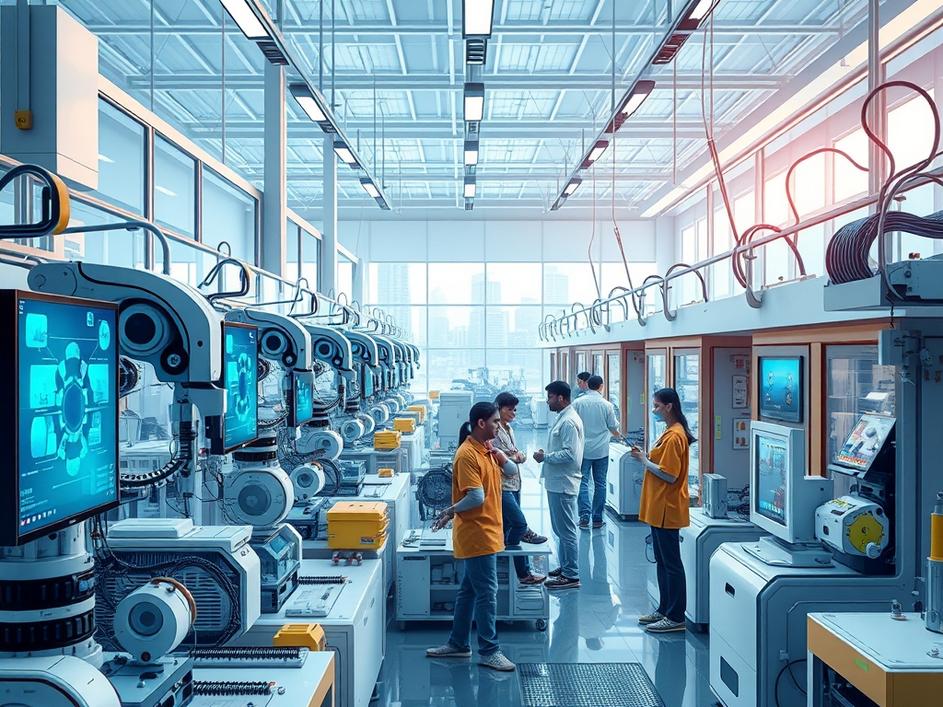


We are a digital agency helping businesses develop immersive, engaging, and user-focused web, app, and software solutions.
2310 Mira Vista Ave
Montrose, CA 91020
2500+ reviews based on client feedback

What's Included?
ToggleIndia is on the cusp of something big. For years, we’ve talked about becoming a global manufacturing hub, a place where innovation thrives and goods are made efficiently for the world. Now, it feels like that vision is getting some serious horsepower. NITI Aayog, our country’s key policy think tank, has laid out a ten-year plan. This isn’t just another document; it’s a detailed roadmap to build a manufacturing world that uses the smartest technologies out there. Think less old-school factory lines and more advanced systems where machines talk to each other, and everything runs smoother and smarter. It’s about moving India’s factories into a future that’s efficient, forward-thinking, and ready to compete on a global scale. This is a crucial step towards realizing our economic ambitions and making ‘Made in India’ truly stand for cutting-edge quality and innovation.
So, what does this \“smart tech\” actually mean for our factories? We’re talking about technologies that are already changing industries worldwide. Imagine artificial intelligence (AI) making production lines smarter by predicting problems before they happen. Think about the Internet of Things (IoT), where every machine is connected, sharing data to make processes more efficient. Robotics, of course, will play a huge role, handling repetitive tasks and allowing human workers to focus on more complex, creative jobs. And then there’s additive manufacturing, or 3D printing, which lets us create intricate parts on demand, reducing waste and opening up new design possibilities. These aren’t just fancy gadgets; they are the building blocks of what people call Industry 4.0. For India, adopting these means we can produce higher quality goods, often at a lower cost, and be much more flexible to what the market needs. It means we can move beyond just basic assembly and start making complex, high-value products that require precision and advanced engineering.
Having great technology is one thing; making it easy to use and develop is another. NITI Aayog’s plan wisely addresses the often-tricky world of rules and regulations. One big piece is creating clear rules around intellectual property (IP). If someone invents a new process or a unique product, they need to know their ideas are protected. This gives innovators the confidence to invest their time and money, knowing their hard work won’t just be copied. Think of it as putting up a fence around a creative idea. Beyond IP, the plan also talks about making it simpler to get approvals for using modern technologies in manufacturing. No one wants to wait months or years for a permit to try out a new, efficient machine. Streamlined approvals mean less red tape and faster adoption of good ideas. These policy changes are like removing speed bumps from the road to innovation, making it easier for businesses to grow and adopt the new technologies that will drive our economy forward.
It’s easy to get excited about robots and AI, but a true industrial evolution also needs to focus on people and the planet. This roadmap isn’t just about machines; it’s about the workforce of the future. As factories get smarter, the types of jobs will change. We’ll need people who can design these systems, manage them, troubleshoot them, and work alongside intelligent machines. So, a big part of this plan must involve serious investment in training and skill development. It’s about making sure our young people are ready for these new roles, turning potential job losses from automation into opportunities for higher-skilled, better-paying work. And crucially, the plan emphasizes easy access to green and advanced materials and processes. This means manufacturing can grow without harming the environment, focusing on sustainability. It’s a forward-thinking approach that recognizes economic growth and environmental responsibility can, and should, go hand in hand. This holistic view is vital for building an industry that truly lasts.
A ten-year roadmap is ambitious, and rightly so. This journey won’t be without its bumps. There will be challenges like securing the right kind of investment, making sure smaller businesses can also adopt these technologies, and continuously updating our education system to meet new demands. But the potential rewards are immense. If India successfully implements this vision, we could see a massive boost in economic growth, the creation of millions of new jobs, and a significant jump in our global competitiveness. We could become known not just for our IT services, but also for our cutting-edge manufacturing. This plan offers a chance to build an industry that is resilient, adaptable, and a leader in innovation. It’s about building a future where \“Made in India\” signifies not just origin, but also advanced technology, quality, and environmental consciousness. This is a moment for big thinking and bold action.
NITI Aayog’s detailed plan for a technology-driven manufacturing ecosystem is more than just a policy paper; it’s a blueprint for India’s economic future. It touches on all the key areas: embracing advanced technologies, creating supportive policies, protecting innovation, empowering our workforce, and ensuring sustainability. This isn’t just about making more things; it’s about making them better, smarter, and with a long-term vision for prosperity and global leadership. The next decade holds the promise of truly reshaping India’s industrial landscape, turning our factories into hubs of innovation and efficiency. It’s an exciting prospect that could lead to a stronger, more dynamic India for generations to come. This journey will require commitment and collaboration from all sides, but the destination \– a technologically advanced, globally competitive manufacturing sector \– is well worth the effort.



Leave a reply